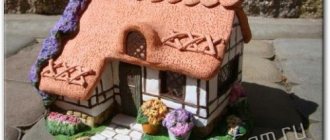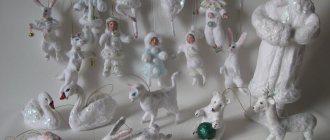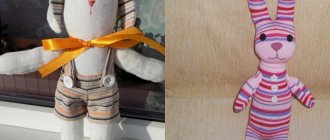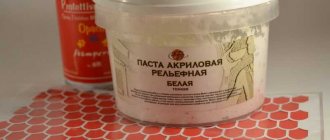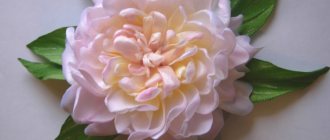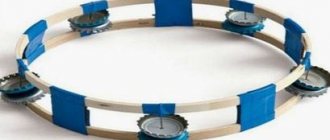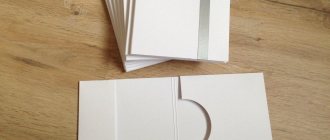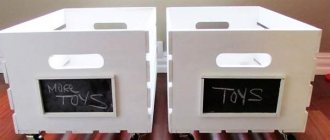Dimensions
The height and weight of cats can vary depending on the breed and the specific individual (it’s not a wide bone, but fluffy hair!), so the dimensions of the house depend primarily on this. Free space in the apartment also plays an important role - for cramped housing a small, simple stand is suitable, for a spacious country house - an impressive play complex with tunnels, scratching posts and hanging toys. The configuration and appearance of the structure can be absolutely anything - the variety of modern finishing materials provides wide scope for imagination.
What is an ottoman?
This piece of furniture is intended for a seat or as a footrest. If we consider the pouf as a house for a cat, then it will be soft and covered with a special fabric. On it the animal is located on top or inside. To remake a regular pouf for a cat, you need to cut a hole for the entrance and upholster the inside. Then the fluffy will be able to relax in it in his free time.
When choosing a place for an ottoman, you should take into account the cat’s choice and place the sleeping and playing area in a warm place, because cats do not like cold and drafts.
Requirements for a scratching post
The stand combined with a scratching post is chosen by the furry pet, but the burden of creating a cat stand with your own hands falls on the owner. The range of pet stands offered in pet stores is wide, but there are specific requirements for the design:
- Sustainability. The stand should remain stationary during cat play. Therefore, you should not choose hanging models - they are not as stable as those that are attached to the wall or installed on the floor with a stand.
- Dimensions. All the hand-made cat stands in the photo are very tall. You can determine the appropriate size of a scratching post by taking a closer look at the place where your cat most often sharpens its claws and measuring the height at which it is located.
- The stand should be placed in a place convenient for the cat.
- In terms of structure and roughness, the scratching post should correspond to the pet’s preferences and not harm him.
An old and worn-out stand should not be changed: as a rule, the cat gets used to it, and the disappearance of a favorite toy can negatively affect the psychological state of the pet. Therefore, after the cat stand is made with your own hands, it is installed next to the old one. When the new version of the scratching post is used more often, the outdated one is thrown away.
Types of ottomans
Open pouf
This piece of furniture for animals can be made with sides.
Sun loungers that have no entrance, exit or roof. Outwardly they look simple - a soft place with or without sides. Thanks to the filling of such upholstered furniture, the kitten will always be warm, which will add coziness and comfort. The animal will be happy to use such an acquisition. In addition, open ottomans allow the pet to observe the surrounding environment.
Closed house
For lovers of peace and quiet, it is better to consider housing options in which cats can retire from strangers and relax peacefully. If the animal has kittens or the cat is pregnant, then she and her offspring will be more comfortable in an enclosed space and the owners will not need to worry about damaged things or furniture. This can be a lounger with a removable top for a kitten or a regular closed ottoman with an entry hole.
Base materials
The frame of a cat stand with your own hands is made from different materials, but preference is given to the following:
- Rattan.
- Paper tubes.
- Chipboard, MDF, fiberboard.
- Natural wood.
- Plywood.
- Plastic.
- Thick cardboard.
Shelves, booths and play complexes are often constructed from boards - laminate, lining, plastic containers, papier-mâché or corrugated boxes. Materials should not have strong, toxic odors. Baskets are woven from magazine, newspaper and paper tubes, wicker, roots, rattan or cut plastic bottles.
Sheathing materials
Since cats prefer to sleep on something soft, warm and comfortable, you need to choose the appropriate upholstery for the house: carpet, foam rubber, faux fur, furniture fabric or padding polyester.
All surfaces in play complexes are covered with fabric except for scratching posts - they are wrapped with twine or hemp rope. As a filler for mattresses and pillows, synthetic winterizer, foam rubber or granular material that retains heat is used.
For shedding and long-haired cat breeds, it is advisable to choose beds from the surface of which hair can easily be collected. The color of the textile should match the shade of the animal’s fur so that individual hairs will not be noticeable.
Mini cat ladder
There are cats that are calm, and there are those that just need somewhere to climb and climb.
For these cats, you can make an original mini-staircase in your apartment.
It will also ensure the safety of a cat passing by the door.
The mini staircase is a fantastic idea!
For cats, this is a real podium, located beautifully along the wall and above the door.
At the end of the stairs there is a cat bed.
To prevent you from falling down the stairs, there are mats glued to the steps.
SHARE WITH YOUR FRIENDS
Mounting methods
In the manuals on how to make a stand for a cat with your own hands, it is recommended to attach the structure to plastic or metal corners in such a way that the animal cannot be injured. Soft parts and fabrics are fixed with a construction stapler - nails should not be used for this purpose, since the stand can become loose and the nails can come out, which is dangerous not only for the cat, but also for the owners. Any glue will do, as long as it has no pungent odor and is not toxic. Houses for cats of an original design - teardrop-shaped or tube-shaped - are secured to a metal frame with carabiners or wire.
Why do you need a scratching post?
This simple item exists not only to save your furniture from attacks by pets and tearing off the upholstery, but also to ensure that your furry pet remains healthy.
It is very important for them to be able to grind down their claws and do it in a timely manner. Otherwise, the claws may become chipped, and this is incredibly painful, even more painful than a pulled out human nail.
A deformed or curled claw makes it impossible for a cat to climb trees or simply walk freely. In some cases, the animal cannot even step on its paw.
Ultimately, discomfort and pain can lead to serious injuries , torn ligaments and even tragic accidents. It is your direct responsibility to provide your pet with everything necessary to maintain health and improve the quality of life.
Floor structures
Floor standing scratching posts are large in size, but in some situations they are irreplaceable. Heavy and flat structures are chosen when the wall material does not allow mounting wall-mounted options. Self-made cat stands are optimal for active and young animals that have nowhere to throw out their energy and cannot go outside. Multi-tiered houses and complexes with beds and toys are suitable for several animals - they can not only frolic in them, but also relax comfortably.
DIY house
Maine Coons love houses where they can curl up and hide from the whole world. Today in stores, manufacturers from all over the world are ready to offer you not only houses and a sleeping place, but even entire complexes consisting of a scratching post, a small hammock, a ladder and a place for a bowl.
When choosing such a complex, it is important to pay attention to the materials from which the structure was assembled. They should not contain any chemicals; preference should be given to natural materials.
But if you haven’t found anything suitable, don’t despair, it’s not difficult to make such a house with your own hands. Let's divide the work into several stages:
- Take measurements. The house should not be too cramped, but it also should not be made huge, it will be uncomfortable.
- Take five wooden boards and cut them according to your measurements. You should now have three walls, a floor and a ceiling.
- Fasten the boards with self-tapping screws.
- To make your cat more comfortable, you can line the interior walls with foam rubber and cover them with fabric using a furniture stapler.
- Place a soft pillow on the floor.
- You can also put a soft pillow on the roof, since Maine Coons love to climb to high places.
Claw posts
According to the master classes and photos offered on the Internet, you can make a cat stand with or without a base and shelf. Long racks, the design of which does not include a base, are attached to the floor or ceiling using metal corners or screws. A do-it-yourself cat stand should be sized to match the height of the animal. An ideal material would be a tree trunk 7-10 centimeters thick or a plastic pipe with a diameter of 5 centimeters, braided with hemp rope, twine or thin rope. Before winding, the pipe is coated with glue, and the rope is tapped with a hammer to ensure a tighter fit of the turns. Since a long stand will require a lot of material, the wooden option is more profitable from a financial point of view, especially if the furry is too active and frequent replacement of the structure is required.
The minimum height of a column with a base is one meter. For the base, use multilayer plywood or a heavy wooden board 50-70 centimeters long and 40-50 centimeters wide. The claw post is created from a dense plastic pipe, which is attached to the base using self-tapping screws, screws or metal corners. The base is also covered with soft textiles - upholstery fabric or carpet, in the center of which a hole is cut for a post. The finishing material is attached with a furniture stapler or glue. At the top of the pipe you can attach a soft toy that can attract the cat's attention.
Running wheel for...cat
It turns out that running wheels are not only for hamsters and chinchillas, but also for cats.
Of course, if a cat has access to the street, then there is no need for it, but for animals locked within four walls, it is necessary to sometimes exercise. A running wheel for a cat is similar to a wheel for small rodents, and according to these instructions, you can make a wheel for them, taking into account the size. To make such a wheel, the master uses the following
Tools and materials: -Rake; -Plywood; -Centimeter; -Miter saw; -Rollers; -Dremel; -Pencil; - Grinder; -Drill; -Glue; -Rope; -Clamps; -Bolt with nut; -Bearing; -Beam; - Fasteners; -Double sided tape; -Carpet; -Knife;
Step one: base The wheel consists of two plywood circles connected by a strip. The radius of the circles is 46 centimeters. Cuts circles from plywood. Connects the circles by placing bars between them.
A little from myself. I don’t know if anyone will make a running wheel for a cat, but for chinchillas, squirrels and hamsters such a device is necessary. Having some family experience in keeping chinchillas, I would like to note the following points: -The planks do not need to be glued to the plywood circles, they can be screwed on; -Installation on rollers, from my point of view, is not convenient; -Rodents are nocturnal animals and you need to choose a wheel with the least noise from roller bearings; -The belt tension roller from the Volga is excellent as a bearing (VAZ rollers are offset and need to be modified); -The running wheel is mounted on the cage without a stand; -For rodents there is no need to glue the path and apply coating. Source
Become the author of the site, publish your own articles, descriptions of homemade products and pay for the text. Read more here.
Stand with stand
Making a cat stand is much easier after studying master classes on creating scratching posts on the base. If the house contains several woolen pets, then the complex is designed in such a way that each animal has its own shelf or bed. They are located on the same level - this way the cats will not experience discomfort. The distance between the posts should not be less than 60 centimeters - otherwise the fluffies will interfere with each other, which can result in a conflict.
You can start making a step-by-step cat stand with your own hands using photos and drawings using the following master class:
- The foundation for the structure is being prepared. In a building with one post, the stand is made in the same way as for a separate post with a base; in the complex, the base is cut out.
- The pipe sections are attached with metal corners to the lower platform.
- A piece of fabric for the covering is cut out with marked holes for the stands. The material is stretched onto the base and secured with staples or glue.
- The posts are wrapped with hemp rope or twine.
- The dimensions of the stand are selected in such a way that it is comfortable for the animal to sit/lie on them. They are attached to the pipes with metal corners.
- On one of the beds there is a house. It is desirable that it be removable and washable. The most convenient fastening option is a zipper: one part of it is sewn to the bed, the second to the base along the perimeter of the house.
It is advisable to attach the completed complex with a stand and stand to the floor to prevent it from being tipped over by cats during games.
Story
Large cats first appeared in the American state of Maine, located in the north of the country. Living conditions in those places are so harsh that natural selection left only the hardiest and strongest animals alive. This is how a breed of large cats, covered with thick hair, was formed.
At first, local farmers did not pay attention to the unusual appearance of their pets. Maine Coons have very developed hunting instincts, and farmers were simply glad that they had such effective helpers in the fight against rodents.
regarding the origin of our heroes. According to one of these legends, a raccoon was inflamed with passion for a cat and, in all likelihood, achieved reciprocity. In fact, the consolidation of the breed occurred through natural selection. Small animals simply would not survive in Maine conditions.
A visiting lover of these animals drew attention to the unusual beauty of northern cats. The tourist left the inhospitable area with a kitten. This was the Maine Coon's first journey into a new life.
Fame came to them only in 1861 at an exhibition in New York. The popularity that flared up after this event quickly faded away. At the turn of the nineteenth and twentieth centuries, Persian cats came into fashion and farmers remembered our heroes again; it was thanks to their ability to fight tailed pests that Maine Coons survived. The breed was officially recognized in 1878. These days, cats are rarely used as mousecatchers; their duties in the family are often limited to companionship.
Errors in making a stand
When assembling a cat stand with their own hands, pet owners often make mistakes by not taking into account certain nuances.
Firstly, reliability and stability are the key to such a design. If the scratching post falls, the cat will quickly jump off and will not be injured, but will no longer approach it out of fear.
Secondly, many owners try to save money on their pet by buying cheap, low-quality materials to create a stand. Such structures quickly become unusable and can cause significant harm to the health of a furry pet.
Thirdly, many owners are of the opinion that their work ends with assembling the rack, and then it’s a cat’s business. A small kitten may not be interested in a new piece of furniture, so it is worth placing his favorite toys on it.
With an adult cat, things are more complicated - if she has not previously sharpened her claws on a special stand, then you will have to accustom her gradually. This process can be facilitated by using a special hemp rope sold at a pet store to wrap the scratching post - it is soaked in valerian or catnip, which attracts the cat's attention. This will allow you to quickly accustom your pet to a new piece of furniture.
Where to begin?
Before you start work, you need to decide on the dimensions and shape of the product. If the DIY cat shelves for the wall are intended only for the pet, the task is greatly simplified. The shelf can be made from natural wood or chipboard. In the latter case, you don’t have to do anything special. They will cut the sheet for you and glue the edge where you purchased the chipboard. All that remains is to connect the parts using confirmations and hang them on the wall.
Important! This option has one drawback - the material is sold in sheets, so there will be a lot of waste, and the costs will be high.
If you make wooden shelves for cats with your own hands, then you will take as much material as you need, and the consumption will be much more rational:
- Cut the board into pieces of the required length.
- Connect the parts with self-tapping screws, confirmats, or use special wood glue.
- After the structure is assembled, varnish or paint it so that the shelf fits into the interior.
- You can hang the finished product on the wall using dowels or brackets.
- A hanging ladder can be made from furniture slats, cut into pieces of various lengths, and ordinary rope.
Important! To ensure that the lamella pieces are at the same distance, you can tie knots in the rope or use large beads and nuts as limiters.

